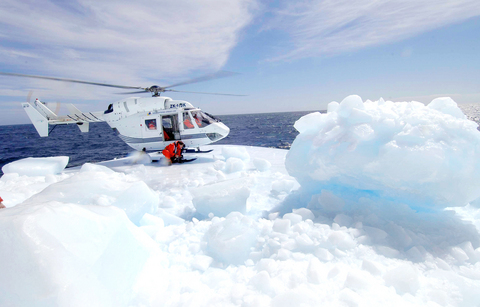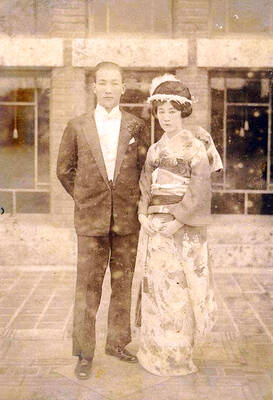Australian tycoon and adventurer Dick Smith says he will "revisit" his 30-year-old dream of towing icebergs from Antarctica to Australian cities like Perth or Sydney to break his country's crippling drought.
"This isn't a crazy idea," he says, "but it is bold, and the time and necessary technology might just be right."
Smith's interest was re-ignited after two vast clusters of icebergs drifted to within 260km of the southern New Zealand city of Invercargill on Nov. 6.

PHOTO: AFP
It was the nearest reported approach of an iceberg to New Zealand since 1931, when one appeared over the horizon from a Dunedin beach.
Until Wednesday when the floating ice mountains, which were expected to break up and melt before being visible from land, re-appeared about 60km from the coast and were visited by reporters winched down on to them from helicopters.
Among the flotillas of bergs first spotted by a Royal New Zealand Air Force patrol flight were some that were around 2km long.
They towered more than 130m above the surface, which in terms of being the proverbial "tip" of an iceberg, meant that an icy keel with a depth of around 900m of ice lay hidden below the waterline.
The ice armadas, comprising both major bergs and thousands of lumps down to the size of trucks took maritime authorities by surprise.
Marine scientists said the emptiness of the southern oceans and skies compared to the busy air and sea lanes of the North Atlantic allowed the ice armadas to approach undetected.
Nor is there any agreement on whether the outbreak of Antarctic icebergs is climate change related, or just cyclical.
Giant icebergs were seen off Tasmania early in the 20th century and by Spanish explorers off Brazil in the 18th century, when the world was cooler, and the all time record for a northern sighting of southern ice was recorded in 1894, in the mid Atlantic Ocean only 400km short of the tropic of Capricorn.
In 1976, Dick Smith championed an idea that had been proposed ever since the start of the last century to tow icebergs to places where fresh water was scarce.
He chartered the first Boeing 747 sightseeing flights over the fringes of Antarctica to film the enormous ice shelves where glacial streams from the continent pushed their way out to sea as a solid floating mass before calving into icebergs.
"The idea was that since Antarctica locked up 90 percent of earth's fresh water, pushing or pulling the vast chunks that break off toward a southern city like Adelaide could see them arrive before too much of them melted away, with what was left used to top up the water supply," Smith says.
"But it didn't work."
Detailed studies by Australian Antarctic scientists and engineers including the advanced notion of using giant nuclear powered tugs concluded that even if suitably sized bergs could be shrouded in plastic to slow down the melting, the end result would be an enormous plastic bag full of melt water that would cause so much drag it would scarcely move, and use too much energy to be worthwhile.
"But I discovered it could work as a stunt to generate publicity," Smith says. "On April 1, 1978 we had a tug tow a barge we had secretly buried under white plastic foam into Sydney Harbor at dawn. Two hundred of my employees rang radio stations to say "It looks like an ice berg is coming through the heads."
"It was incredible. Thousands of people drove out to the north and south headlands to gaze on the spectacle. The navy rang me to tell me where to moor the first iceberg they had ever welcomed to an Australian port. I announced my electronics company was going to carve it into "Dicksicles" that people could use to chill their cocktails.
And then the penny dropped, but fortunately, everyone had a good laugh."
It became immortalized as one of the world's best April Fool's Day jokes of all time.
But now Australia is desperately short of fresh water. It has been gripped by drought since 1999. Its major cities, where two in every three Australians live, will start to run dry in as little as four years, as much from the evaporation of dwindling catchments swept by remorselessly hot winds as from (increasingly restricted) consumption.
"I'm going to look at this again," says Smith, who says the age of more efficient super tankers may have met the dire need for more water at just the right time.
"We don't need to try and get the giant tabular bergs all the way to Adelaide or Perth at all," he says. "Why not just nudge them a little bit faster to latitudes where they will start to melt copiously, and meet them with a properly equipped flotilla of super tankers to take the water on board and then more efficiently deliver it right into city water supplies."
Smith is very well connected in business, government and conservation circles. "People might laugh at the idea," he says, "but perhaps not as much as before. Then we might all have another good long think about it."

Under pressure, President William Lai (賴清德) has enacted his first cabinet reshuffle. Whether it will be enough to staunch the bleeding remains to be seen. Cabinet members in the Executive Yuan almost always end up as sacrificial lambs, especially those appointed early in a president’s term. When presidents are under pressure, the cabinet is reshuffled. This is not unique to any party or president; this is the custom. This is the case in many democracies, especially parliamentary ones. In Taiwan, constitutionally the president presides over the heads of the five branches of government, each of which is confusingly translated as “president”

Sept. 1 to Sept. 7 In 1899, Kozaburo Hirai became the first documented Japanese to wed a Taiwanese under colonial rule. The soldier was partly motivated by the government’s policy of assimilating the Taiwanese population through intermarriage. While his friends and family disapproved and even mocked him, the marriage endured. By 1930, when his story appeared in Tales of Virtuous Deeds in Taiwan, Hirai had settled in his wife’s rural Changhua hometown, farming the land and integrating into local society. Similarly, Aiko Fujii, who married into the prominent Wufeng Lin Family (霧峰林家) in 1927, quickly learned Hoklo (commonly known as Taiwanese) and

The Venice Film Festival kicked off with the world premiere of Paolo Sorrentino’s La Grazia Wednesday night on the Lido. The opening ceremony of the festival also saw Francis Ford Coppola presenting filmmaker Werner Herzog with a lifetime achievement prize. The 82nd edition of the glamorous international film festival is playing host to many Hollywood stars, including George Clooney, Julia Roberts and Dwayne Johnson, and famed auteurs, from Guillermo del Toro to Kathryn Bigelow, who all have films debuting over the next 10 days. The conflict in Gaza has also already been an everpresent topic both outside the festival’s walls, where

The low voter turnout for the referendum on Aug. 23 shows that many Taiwanese are apathetic about nuclear energy, but there are long-term energy stakes involved that the public needs to grasp Taiwan faces an energy trilemma: soaring AI-driven demand, pressure to cut carbon and reliance on fragile fuel imports. But the nuclear referendum on Aug. 23 showed how little this registered with voters, many of whom neither see the long game nor grasp the stakes. Volunteer referendum worker Vivian Chen (陳薇安) put it bluntly: “I’ve seen many people asking what they’re voting for when they arrive to vote. They cast their vote without even doing any research.” Imagine Taiwanese voters invited to a poker table. The bet looked simple — yes or no — yet most never showed. More than two-thirds of those